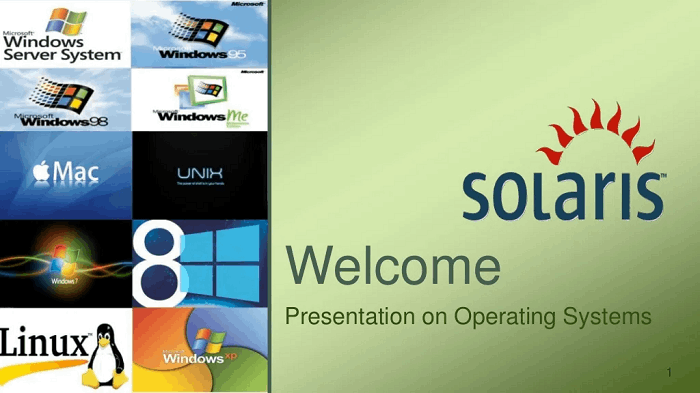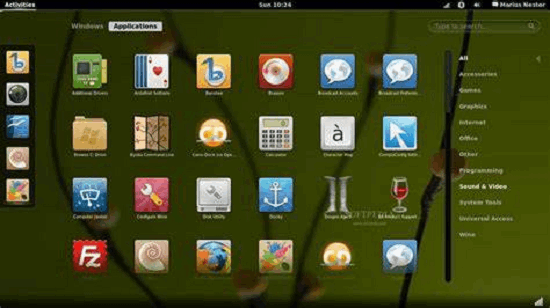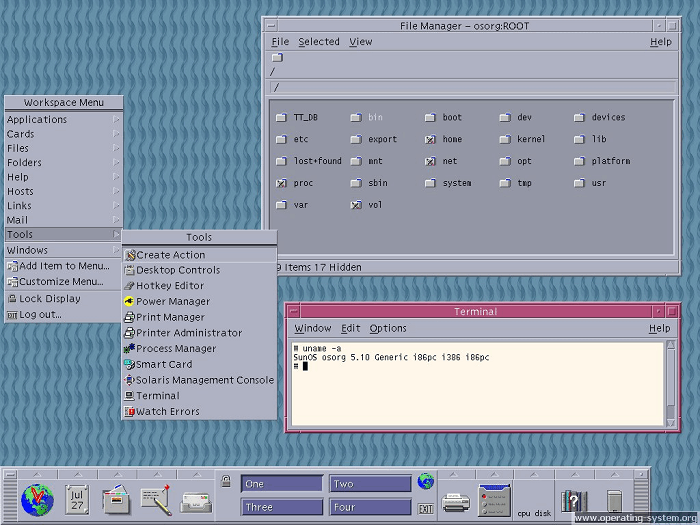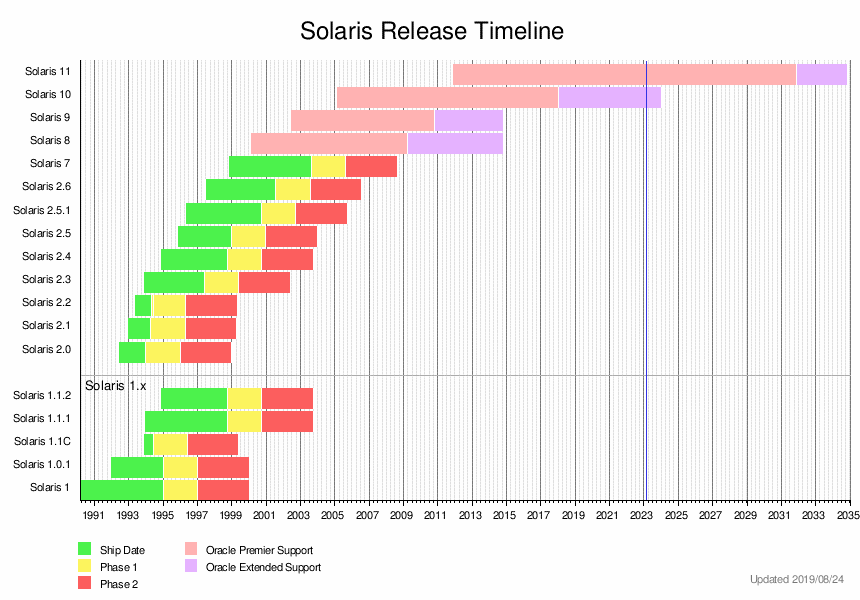Solaris Operating System
Solaris was given to it following Sun's purchase by Oracle in 2010. It quickly gained a reputation for being scalable, particularly on SPARC systems, and for being the source of many ground-breaking features like DTrace, ZFS, and Time Slider. Solaris support Oracle and other manufacturers' SPARC and x86-64 desktops and servers. Solaris was listed as compatible with the Single UNIX Definition until April 29, 2019.
- Solaris was initially created as a private piece of software. Sun Microsystems established the OpenSolaris open-source initiative in June 2005 and distributed most of the codebase under the CDDL licence.
- Sun aimed to create a user and creator community around the programme with OpenSolaris. Oracle decided to stop supporting both the OpenSolaris distribution and the OpenSolaris development paradigm following its purchase of Sun Microsystems in January 2010.
- After that, OpenSolaris was split into illumos, which is still used in several illumos versions today. Oracle terminated the majority of the Solaris employees in September 2017.
Solaris 11's kernel source code was revealed in 2011. Only the code for Solaris 11's open-source components is accessible for download from Oracle due to Solaris' proprietary development methodology. Industry collaborators can access the Solaris source code during development via the Oracle Technology Network (OTN).

History
The three most famous Unix versions available at the time—Berkeley Software Distribution, UNIX System V, and Xenix—were to be combined; it was revealed in 1987 by AT&T Corporation and Sun. Thus, Unix System V Version 4 was created (SVR4).
On September 4, 1991, Sun declared it would switch to SVR4 from its current SunOS 4, a BSD-derived Unix. Internally, this was known as SunOS 5, but at the same time, a new commercial name—Solaris 2—was unveiled. SunOS 5.4, for instance, is included in Solaris 2.4. The 2. was deleted from the release name after Solaris 2.6. SunOS 5.7 is incorporated into Solaris 7, and the most recent version, SunOS 5.11, serves as the foundation of Solaris 11.4.
The first two versions of Solaris 2, 2.0 and 2.1, were SPARC-only even though SunSoft indicated in its original Solaris 2 news release that they intended to support both SPARC and x86 systems ultimately. In June 1993, roughly six months after the SPARC introduction, Solaris 2.1 was made available as a desktop and workgroup server operating system for x86 processors. The Wabi emulator was included to enable Windows apps. Solaris 2.4, which supported both SPARC and x86 computers from a single source code base, was published by Sun in 1994. Despite significantly reducing the engineering team working on Solaris development at Oracle, Solaris 11.4 was published in 2018.
Backed-up systems
The 64-bit SPARC and x86-64 platforms that Solaris offer to share a similar code base. It has traditionally been closely interwoven with Sun's SPARC hardware, which is sold as a combined package (including support for 64-bit SPARC programmes since Solaris 7). As a result, systems are now more dependable but at a higher expense than standard Computer hardware. But since Solaris 2.1 and 10, respectively, it has enabled x86 systems and 64-bit x86 apps, enabling Sun to take advantage of the accessibility of widely affordable 64-bit Processors built on the x86-64 architecture. The following manufacturers offer Solaris compatibility for their x86 server platforms as of 2009:
- Dell: "Solaris and OpenSolaris will be tested, certified, and optimised on its rack and blade servers and made available as one of several options in the total Dell software selection."
- Intel: Hewlett Packard Enterprise distributes and offers professional software assistance for Solaris on the BL, DL, and SL platforms. Fujitsu Siemens.
Various systems
The PowerPC architecture (PowerPC Reference Platform) was supported in Solaris 2.5.1, but the port was abandoned before the introduction of Solaris 2.6. The relevant components from Solaris 2.5.1 were re-integrated into OpenSolaris as part of a community project known as Blastwave and Project Pulsar. This project made its first formal source code release in October 2006. A group of Blastwave engineers started developing Polaris, a PowerPC version, in January 2006.
Although it was proposed in 1997, Solaris was never released for the Intel Itanium platform. Additionally, Solaris supports the Linux platform's ABI, which enables Solaris to execute pure Linux binaries on x86 computers.

Options for installation and use
Solaris can be loaded from various pre-packaged software sets, from a comprehensive Entire Plus OEM to a basic Reduced Network Support. It is not required to install Solaris to use the system. Additionally, bundled versions of other programmes, such as Apache, MySQL, etc., are available from sunfreeware[40] and OpenCSW for installation. Installing Solaris from hard media or a network for use on a laptop or server is an option, but it can also be used without doing so.
- In earlier versions of Solaris, OpenWindows served as the default window interface. In Solaris 2.0 to 2.2, OpenWindows allowed SunView apps from the company's earlier desktop environment and NeWS and X applications. News-enabled object-oriented programme development using PostScript, a widely used printing language introduced in 1982.
- The X Window System was developed by MIT's Project Athena in 1984 and enabled a network link to separate an application's display from the computer it was being used. The initial SunView programme bundle was converted to run on X.
With OpenWindows 3.3, which came with Solaris 2.3, Sun stopped supporting old SunView apps and NeWS and moved to X11R5 with Display Postscript support. OpenWindows 3.6.2 was the final version under Solaris 8, and it continued to use OPEN LOOK as the basis for the graphical appearance and experience. In Solaris 9, the OPEN LOOK Window Manager (olwm) and other OPEN LOOK-specific programs were removed, but support modules were still included, ensuring long-term code compatibility with current programmes. You can still obtain the OPEN LOOK Virtual Window Manager for Solaris from sun freeware, which runs on as late versions as Solaris 10.

Sun released a beta version of GNOME 1.4, an open-source desktop environment built on the GTK+ framework, for Solaris 8 in 2001. GNOME 2.0 debuted on Solaris 9 on August 8, 2003, as a replacement for CDE. Since 2003, Sun has invested in Project Looking Glass, a novel desktop interface. Since late 2006, the initiative has been dormant.
License
Traditional licence for an operating system (1982 to 2004)
For versions of Solaris until 2005 (Solaris 9), the software was distributed under a licence that allowed users to purchase licences in quantity and run the programme on as many computers as they wished. The principal contract was given:
The agreement also included a "License to Develop" that granted the ability to produce derivative works, limited copying to only one historical duplicate, disclaimed guarantees, and similar terms. Through 2004, the title only changed a little.
Restricted source after Sunday (March 2010 to present)
After the board objected to Oracle's position on the project in 2010, when Oracle purchased Sun, the OpenSolaris project was abandoned. The previously open-source Solaris 10 operating system was given a restrictive licence in March 2010 that restricted its use, change, and transfer. After downloading it via the Oracle Technology Network, the licence permitted the gratis 90-day sample use of the operating system. The Customer would then need to buy a maintenance contract from Oracle to keep using the operating system after that trial time. Solaris can be updated to each new "point version without a support agreement," but monthly patches and changes are only available with a support agreement.

Version in development
Since work on what would ultimately become Solaris 2.0 started in the late 1980s, the core Solaris codebase has been continuously developed. Every iteration, including Solaris 10, is built using a snapshot of this development codebase that was captured just before the release and is then kept up to date as a derived project. Since Solaris 10's introduction in 2005, Sun has been working on a new operating system version under the codename Nevada, which is based on the OpenSolaris source.
- A new step in the Solaris development procedure was started in 2003. Later modifications to this software brought about a quarterly release schedule with assistance, now known as Solaris Express Developer Edition (SXDE).
- Sun introduced Project Indiana in 2007 with several objectives, including replacing SXDE with an open-source binary release of the OpenSolaris project. This distribution's initial version was OpenSolaris 2008.05.
- OpenSolaris engineers were the only group for whom the Solaris Express Community Version (SXCE) was created. Until its discontinuation in January 2010, it received updates every two weeks and advised users to switch to the OpenSolaris operating system.
- Although the licence agreement presented when the user installs these images includes additional uses, such as business and production settings, the download licence is seen when obtaining the image files, indicating its use is limited to personal, instructional, and trial reasons.
Releases of SXCE ended with build 130, and those of OpenSolaris ended with build 134 a few weeks afterward. Although the packages were made accessible on the package repository, the next OpenSolaris version based on build 134 was scheduled for distribution in March 2010 but was never completed. Instead, Oracle modified the conditions of the licence, renamed the binary version Solaris 11 Express, and published build 151a as 2010.11 in November 2010.
Derivatives of open-source current
- illumos - Launched in 2010 by a group of Sun OpenSolaris developers and Nexenta OS, illumos is a derivative of the entirely open-source project. Be aware that OpenSolaris was not entirely open source; Sun (now Oracle) had to license certain drivers and modules they could not distribute.
- OpenIndiana - An initiative under the illumos banner to "...becoming the de facto OpenSolaris version deployed on production systems where security and issue patches are needed free of charge."
- SchilliX - The first LiveCD made available after publicly publishing the OpenSolaris source code.
- napp-it, a web-managed ZFS storage device with a Free and Pro version built on Solaris and free derivatives like OmniOS.
- NexentaStor - Nexenta OS-based storage task optimization.
- SmartOS, a Joyent clone with a focus on virtualization.
- OpenSolaris - A Sun Microsystems initiative abandoned after Oracle bought it.
- The first release built on Ubuntu userland with a Solaris-derived kernel was Nexenta OS (discontinued on October 31, 2012).
- StormOS, a remote desktop operating system built on Xfce and Nexenta OS, was terminated on September 14, 2012.
- MartUX - Martin Bochnig published an early version of the first OpenSolaris distribution for SPARC in April 2006. It was initially released as a Live CD, but since the Blastwave community software has been added, it is now only accessible on DVD. Becoming a PC operating system was its main objective. In the summer of 2006, a compact Live CD known as marTux 0.2 Live CD, the first pure OpenSolaris version for SPARC, was made available (not to be confused with the GNOME metacity theme).
- Later, it was given the name MartUX, and the following versions came with both the Live media and complete SPARC drivers. Much later, when Oracle and MartUX were purchased, Sun was upgraded to the first OpenSolaris release to handle both SPARC and Intel architectures; it was rebranded as OpenSXCE.
- MilaX is a compact Live CD/Live USB that uses the bare minimum of packages to accommodate 90 MB of picture space.
- Dyson: illumos kernel, GNU userland, and Debian packages. The website is unavailable, and the project is no longer operational.
- EON ZFS Storage - An embedded systems-focused NAS solution.
- Jaris OS, a live Disc that can be installed. According to the IPA, pronounced Yah-Rees in English, to completely support a version of Wine dubbed Madoris that can set up and execute Windows applications at native performance, this installation has undergone extensive modification. Madaris amalgamates Solaris and the Japanese term for Windows, "Mado." "Japanese Solaris" is what Jaris stands for.
- OpenSXCE Notably, OpenSXCE, the first OpenSolaris version built on OpenIndiana with illumos source for SPARC, has now transitioned to a new source code repository based on DilOS.
Reception
In their 2002 evaluation of Solaris 9, Robert Lipschutz and Gregg Harrington from PC Magazine noted: Overall, Sun has continued to develop Solaris 9. Although its more user-friendly administration is appreciated, it won't be sufficient to persuade users. The platform's dependability, adaptability, and strength may be a factor. Additionally, Robert Lipschutz examined Solaris 10:
However, given that Solaris 10 is available for free distribution, any IT manager would be wise to install it on a spare computer and, at the very least, give it a shot. For safely dividing system resources, guaranteeing efficiency, and monitoring the utilization of these containers, Solaris 10 offers a flexible framework. Basic containers can be easily created and filled with useful tools and apps. However, some situations need a lot of fine-tuning. For Network World, Tom Henderson provided an evaluation of Solaris 10:
OSNews' Robert Escue explains: Sun improved Solaris 10 with some really pleasant additions, making it a superior operating system for managers and users. Although it will take some time, the security upgrades are worthwhile. No, Solaris 10 is not flawless. But I believe Solaris 10 is a vast advance over earlier versions for most purposes, including a desktop OS.
Thomas Greene of The Register: We've enjoyed using Solaris 10. It has qualities that we unquestionably appreciate. Creating what it needs to contend with Linux will be simpler than it currently has. It could be a significant rival to Linux, if not a successor.